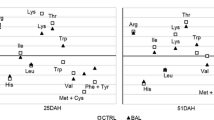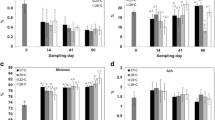Abstract
The present work examined the short- and long-term effects of three rearing temperatures on protein metabolism and growth trajectories of Senegalese sole larvae using 14C-labelled Artemia protein as feed. A first feeding trial was performed on larvae reared at 15, 18 and 21 °C (at 26, 17 and 14 days post-hatching (dph), respectively) and a second trial conducted on post-larvae after transfer to the same rearing temperature (~20 °C) (49, 35 and 27 dph, in larvae initially reared at 15, 18 and 21 °C, respectively). Temperature greatly influenced larvae relative growth rate (RGR) and survival, since growth at 15 °C was severely depressed. Protein digestibility and retention was highest at 18 °C during the first trial (85.35 ± 1.16 and 86.34 ± 2.33 %, respectively). However, during the second trial, post-larvae from 15 °C had the highest feed intake and protein digestibility (3.58 ± 1.54 and 75.50 ± 1.35 %, respectively), although retention was similar between treatments. Furthermore, after transfer to 20 °C larvae from 15 °C experienced compensatory growth, which was observed until 121 dph, and confirmed by RGR values, which were significantly higher at 15 ºC than at 21 ºC or 18 ºC. Results from the present study show that Solea senegalensis larval development, survival and protein digestion and retention are highly affected by thermal history.





Similar content being viewed by others
References
Alami-Durante H, Olive N, Rouel M (2007) Early thermal history significantly affects the seasonal hyperplastic process occurring in the myotomal white muscle of Dicentrarchus labrax juveniles. Cell Tissue Res 327(3):553–570. doi:10.1007/s00441-006-0321-2
Angilletta MJ, Niewiarowski PH, Navas CA (2002) The evolution of thermal physiology in ectotherms. J Thermal Biol 27(4):249–268
Arjona FJ, Ruiz-Jarabo I, Vargas-Chacoff L, del Rio MPM, Flik G, Mancera JM, Klaren PHM (2010) Acclimation of Solea senegalensis to different ambient temperatures: implications for thyroidal status and osmoregulation. Mar Biol 157(6):1325–1335. doi:10.1007/s00227-010-1412-x
Clarke ME, Calvi C, Domeier M, Edmonds M, Walsh PJ (1992) Effects of nutrition and temperature on metabolic enzyme-activities in larval and juvenile red drum, Sciaenops ocellatus, and lane snapper Lutjanus synagris. Mar Biol 112:31–36
Conceição LEC, Dersjant-Li Y, Verreth JAJ (1998a) Cost of growth in larval and juvenile African catfish (Clarias gariepinus) in relation to growth rate, food intake and oxygen consumption. Aquaculture 161(1–4):95–106. doi:10.1016/s0044-8486(97)00260-3
Conceição LEC, Ozorio ROA, Suurd EA, Verreth JAJ (1998b) Amino acid profiles and amino acid utilization in larval African catfish (Clarias gariepinus): effects of ontogeny and temperature. Fish Physiol Biochem 19(1):43–57
Conceição LEC, Morais S, Rønnestad I (2007a) Tracers in fish larvae nutrition: a review of methods and applications. Aquaculture 267(1–4):62–75. doi:10.1016/j.aquaculture.2007.02.035
Conceição LEC, Ribeiro L, Engrola S, Aragão C, Morais S, Lacuisse M, Soares F, Dinis MT (2007b) Nutritional physiology during development of Senegalese sole (Solea senegalensis). Aquaculture 268(1–4):64–81. doi:10.1016/j.aquaculture.2007.04.030
Conceição LEC, Aragão C, Rønnestad I (2011) Proteins. In: Holt J (ed) Larval fish nutrition, 1st edn. Wiley, UK, pp 83–116
Costas B, Aragao C, Ruiz-Jarabo I, Vargas-Chacoff L, Arjona FJ, Mancera JM, Dinis MT, Conceição LE (2011) Different environmental temperatures affect amino acid metabolism in the eurytherm teleost Senegalese sole (Solea senegalensis Kaup, 1858) as indicated by changes in plasma metabolites. Amino Acids. doi:10.1007/s00726-011-1082-0
Dinis MT (1986) Quatre Soleidae de léstuaire du Tage. Reprodution et croissance. Essay d’elevage de Solea senegalensis Kaup. Université de Bretagne Occidentale, Brest
Dou SZ, Masuda R, Tanaka M, Tsukamoto K (2005) Effects of temperature and delayed initial feeding on the survival and growth of Japanese flounder larvae. J Fish Biol 66((2):362–377. doi:10.1111/j.1095-8649.2004.00601.x
Engrola S, Mai M, Dinis MT, Conceição LEC (2009) Co-feeding of inert diet from mouth opening does not impair protein utilization by Senegalese sole (Solea senegalensis) larvae. Aquaculture 287(1–2):185–190. doi:10.1016/j.aquaculture.2008.10.036
Engrola S, Dinis MT, Conceição LEC (2010) Senegalese sole larvae growth and protein utilization is depressed when co-fed high levels of inert diet and Artemia since first feeding. Aquac Nutr 16(5):457–465. doi:10.1111/j.1365-2095.2009.00682.x
Fernandez-Diaz C, Yufera M, Canavate JP, Moyano FJ, Alarcon FJ, Diaz M (2001) Growth and physiological changes during metamorphosis of Senegal sole reared in the laboratory. J Fish Biol 58(4):1086–1097. doi:10.1006/jfbi.2000.1514
Finn RN, Fyhn HJ (2010) Requirement for amino acids in ontogeny of fish. Aquac Res 41(5):684–716. doi:10.1111/j.1365-2109.2009.02220.x
Fonds M (1979) Laboratory observations on the influence of temperature and salinity on development of the eggs and growth of the larvae of Solea–Solea (Pisces). Mar Ecol Prog Ser 1(2):91–99
Green BS, Fisher R (2004) Temperature influences swimming speed, growth and larval duration in coral reef fish larvae. J Exp Mar Biol Ecol 299(1):115–132. doi:10.1016/j.jembe.2003.09.001
Handeland SO, Imsland AK, Stefansson SO (2008) The effect of temperature and fish size on growth, feed intake, food conversion efficiency and stomach evacuation rate of Atlantic salmon post-smolts. Aquaculture 283(1–4):36–42. doi:10.1016/j.aquaculture.2008.06.042
Houde ED (1974) Effects of temperature and delayed feeding on growth and survival of larvae of 3 species of subtropical marine fishes. Mar Biol 26(3):271–285
Houde ED (1989) Comparative growth, mortality, and energetics of marine fish larvae—temperature and implied latitudinal effects. Fish B-Noaa 87(3):471–495
Huang G, Wei L, Zhang X, Gao T (2008) Compensatory growth of juvenile brown flounder Paralichthys olivaceus (Temminck & Schlegel) following thermal manipulation. J Fish Biol 72(10):2534–2542. doi:10.1111/j.1095-8649.2008.01863.x
Imsland AK, Foss A, Gunnarsson S, Berntssen MHG, FitzGerald R, Bonga SW, Von Ham E, Naevdal C, Stefansson SO (2001) The interaction of temperature and salinity on growth and food conversion in juvenile turbot (Scophthalmus maximus). Aquaculture 198(3–4):353–367
Imsland AK, Foss A, Conceição LEC, Dinis MT, Delbare D, Schram E, Kamstra A, Rema P, White P (2003) A review of the culture potential of Solea solea and S-senegalensis. Rev Fish Biol Fish 13(4):379–407
Johnston IA, Hall TE (2004) Mechanisms of muscle development and responses to temperature change in fish larvae. In: Govoni JJ (ed) The development of form and function in fishes and the question of larval adaptation, vol 40. American Fisheries Society Symp, Bethesda, Maryland, pp 113–144
Keller AA, Klein-MacPhee G (2000) Impact of elevated temperature on the growth, survival, and trophic dynamics of winter flounder larvae: a mesocosm study. Can J Fish Aquat Sci 57(12):2382–2392
Lankin KF, Peck MA, Buckley LJ, Bengtson DA (2008) The effects of temperature, body size and growth rate on energy losses due to metabolism in early life stages of haddock (Melanogrammus aeglefinus). Mar Biol 155(5):461–472. doi:10.1007/s00227-008-1043-7
Mai MG, Engrola S, Morais S, Portella MC, Verani JR, Dinis MT, Conceicao LEC (2009) Co-feeding of live feed and inert diet from first-feeding affects Artemia lipid digestibility and retention in Senegalese sole (Solea senegalensis) larvae. Aquaculture 296(3–4):284–291. doi:10.1016/j.aquaculture.2009.08.024
Morais S, Conceição LEC, Dinis MT, Rønnestad I (2004a) A method for radiolabeling Artemia with applications in studies of food intake, digestibility, protein and amino acid metabolism in larval fish. Aquaculture 231(1–4):469–487. doi:10.1016/j.aquaculture.2003.09.005
Morais S, Lacuisse M, Conceição LEC, Dinis MT, Rønnestad I (2004b) Ontogeny of the digestive capacity of Senegalese sole (Solea senegalensis), with respect to digestion, absorption and metabolism of amino acids from Artemia. Mar Biol 145(2):243–250. doi:10.1007/s00227-004-1326-6
Mylonas C, Anezaki L, Divanach P, Zanuy S, Piferrer F, Ron B, Peduel A, Ben Atia I, Gorshkov S, Tandler A (2005) Influence of rearing temperature during the larval and nursery periods on growth and sex differentiation in two Mediterranean strains of Dicentrarchus labrax. J Fish Biol 67:652–668
Ribeiro L, Sarasquete C, Dinis MT (1999a) Histological and histochemical development of the digestive system of Solea senegalensis (Kaup, 1858) larvae. Aquaculture 171(3–4):293–308
Ribeiro L, Zambonino-Infante JL, Cahu C, Dinis MT (1999b) Development of digestive enzymes in larvae of Solea senegalensis, Kaup 1858. Aquaculture 179(1–4):465–473
Ricker WE (1958) Handbook of computations for biological statistics of fish populations. Bull Fish Res Board Can 119:1–300
Rønnestad I, Conceição L (2005) Aspects of protein and amino acid digestion and utilization by marine fish larvae. In: Starck JM, Wang T (eds) Physiological and ecological adaptations to feeding in vertebrates. Science Publishers, Enfield, NH, USA, pp 389–416
Ronnestad I, Rojas-Garcia CR, Tonheim SK, Conceicao LEC (2001) In vivo studies of digestion and nutrient assimilation in marine fish larvae. Aquaculture 201(1–2):161–175
Rønnestad I, Tonheim SK, Fyhn HJ, Rojas-García CR, Kamisaka Y, Koven W, Finn RN, Terjesen BF, Barr Y, Conceição LEC (2003) The supply of amino acids during early feeding stages of marine fish larvae: a review of recent findings. Aquaculture 227(1–4):147–164. doi:10.1016/s0044-8486(03)00500-3
Savoie A, Le Francois NR, Cahu C, Blier PU (2008) Metabolic and digestive enzyme activity profiles of newly hatched spotted wolffish (Anarhichas minor Olafsen): effect of temperature. Aquac Res 39(4):382–389
Somero GN (2004) Adaptation of enzymes to temperature: searching for basic “strategies”. Comp Biochem Physiol B Biochem Mol Biol 139(3):321–333. doi:10.1016/j.cbpc.2004.05.003
Treberg JR, Hall JR, Driedzic WR (2005) Enhanced protein synthetic capacity in Atlantic cod (Gadus morhua) is associated with temperature-induced compensatory growth. Am J Physiol 288(1):R205–R211. doi:10.1152/ajpregu.00109.2004
Vinagre C, Fonseca V, Cabral H, Costa MJ (2006) Habitat suitability index models for the juvenile soles, Solea solea and Solea senegalensis, in the Tagus estuary: defining variables for species management. Fish Res 82(1–3):140–149. doi:10.1016/j.fishres.2006.07.011
Von Herbing IH (2002) Effects of temperature on larval fish swimming performance: the importance of physics to physiology. J Fish Biol 61(4):865–876. doi:10.1006/jfbi.2002.2118
Acknowledgments
The authors would like to greatly acknowledge J. Sendão, H. Teixeira, F. Rocha and A. Santos from CCMAR (Portugal), for their invaluable help during the experimental set-up and sampling of Senegalese sole larvae. This work was funded by Project EPISOLE [PTDC/MAR/110547/2009] from Fundação para a Ciência e a Tecnologia (FCT), Portugal. C. Campos and S. Engrola acknowledge the financial support by Fundação para a Ciência e Tecnologia, Portugal, through grants SFRH/BD/43633/2008 and SFRH/BPD/49051/2008, respectively.
Author information
Authors and Affiliations
Corresponding author
Rights and permissions
About this article
Cite this article
Campos, C., Castanheira, M.F., Engrola, S. et al. Rearing temperature affects Senegalese sole (Solea senegalensis) larvae protein metabolic capacity. Fish Physiol Biochem 39, 1485–1496 (2013). https://doi.org/10.1007/s10695-013-9802-x
Received:
Accepted:
Published:
Issue Date:
DOI: https://doi.org/10.1007/s10695-013-9802-x




